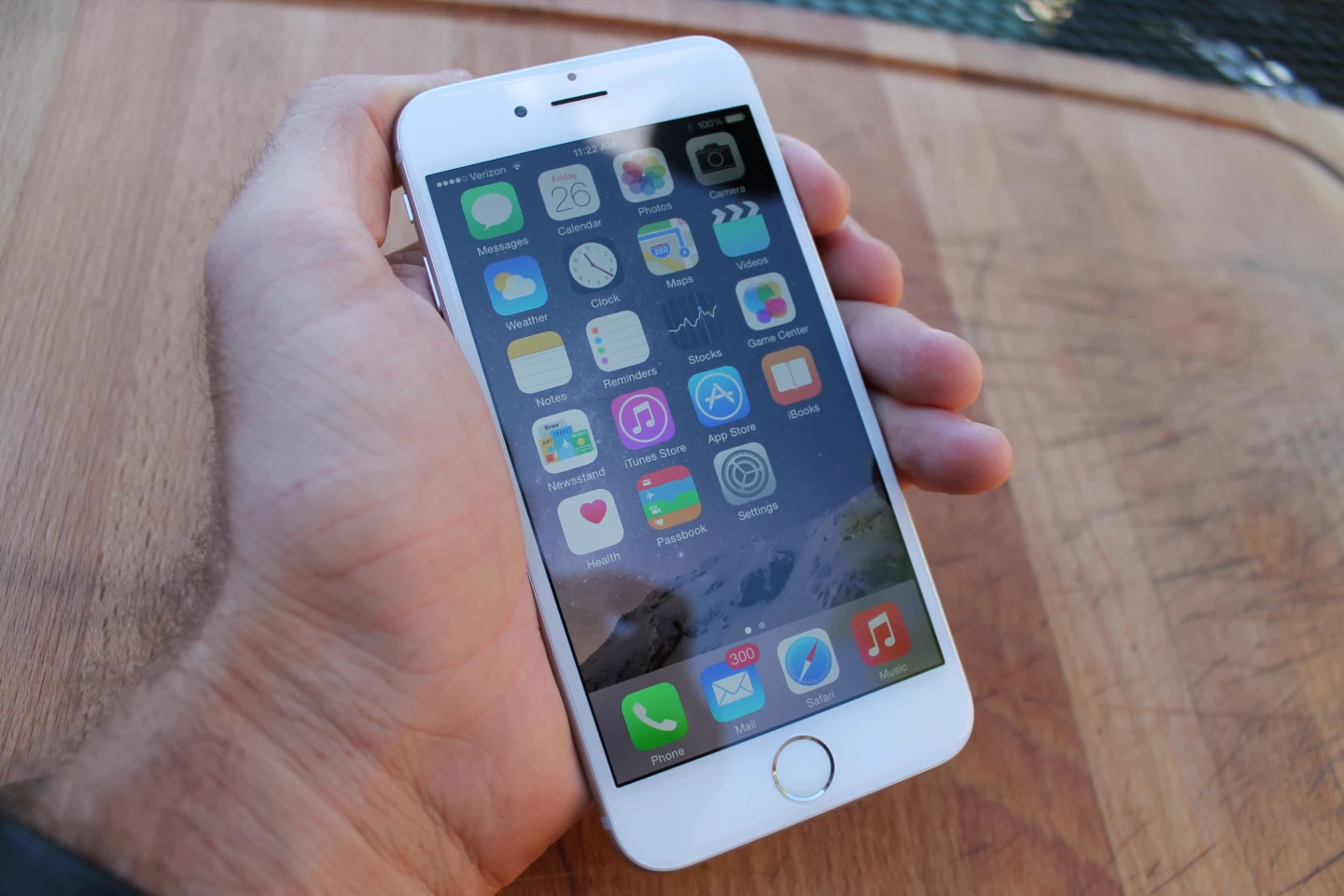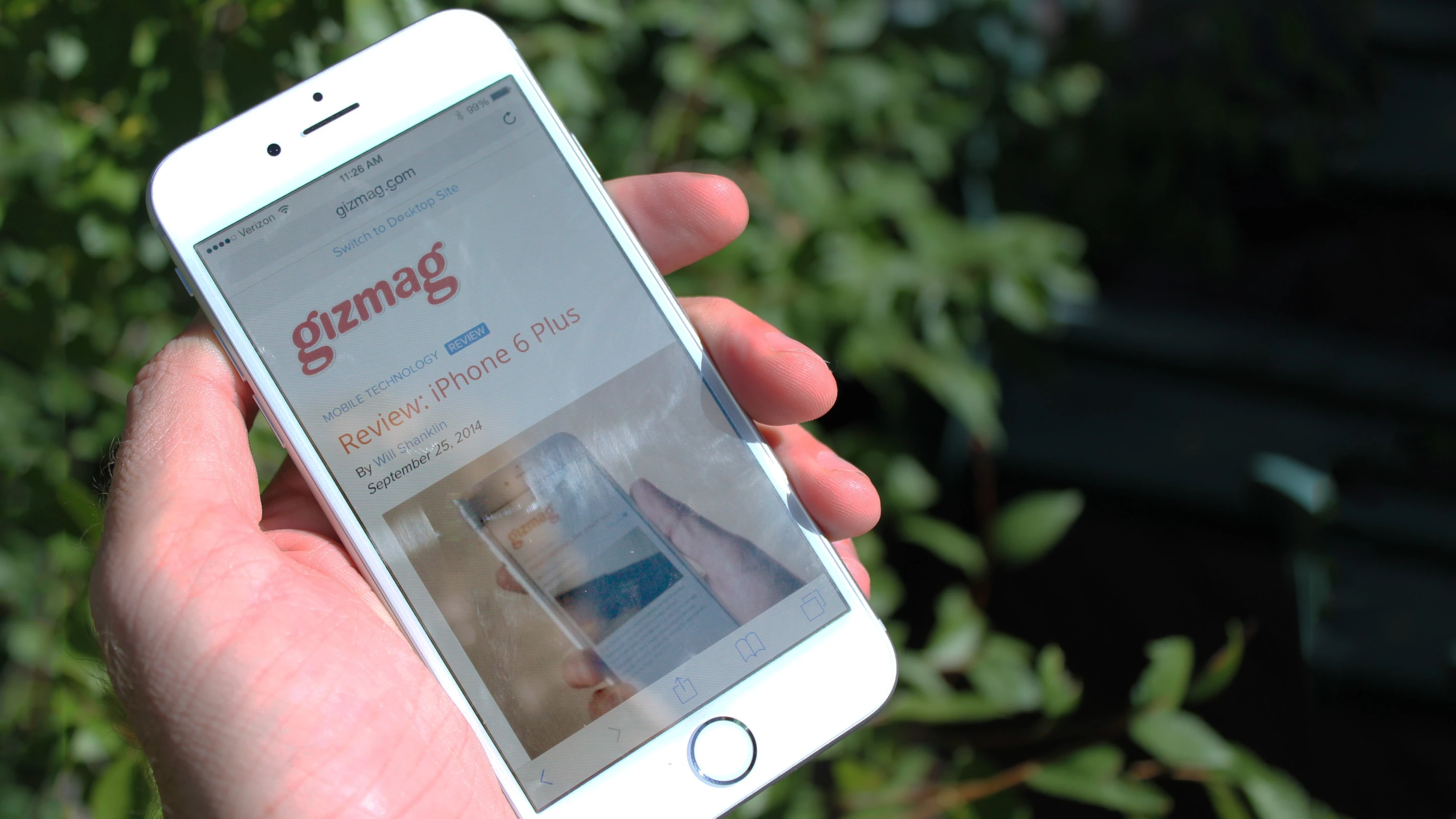Like all its predecessors, the iPhone 6 still proudly touts its origins on its back panel: "Designed by Apple in California." It's more appropriate than ever, because this latest iPhone (and its phablet sibling, the iPhone 6 Plus) is much like California itself. On the whole, it's beautiful. It does many things well and it is arguably the best in the world in a number of categories. Some say it's too expensive, while others contend that's just the price of living on the bleeding edge of innovation and style. Ultimately, it's not perfect and you'll have to tolerate some inefficiencies and ugly areas that seem like they could easily be fixed up, but even with all its flaws, it's still pretty awesome.
By now you've at least seen photos of the iPhone 6 and have a feel for its basic look, but you've really got to get one in your hand to understand the gorgeous design of this device. I wasn't blown away by all the early leaks of the form factor and I'm still not crazy about those strange antenna lines on the back, but the completely smooth, rounded and near seamless design is something to behold in person.
The lack of any squared edges makes for an unexpectedly nice feel in the hand. It's so thin, flat and light that it almost feels frail, but don't worry, this smaller of the two new iPhone siblings doesn't seem to suffer from the same pliability issues as the iPhone 6 Plus. The anodized aluminum and other materials have a premium feel and the curved edge of the glass screen sloping down toward the chassis is indicative of a high degree of attention to detail. To me, it seems like clear evidence that the obsessive-compulsive ghost of Steve Jobs is still stalking the halls of Apple.

Beauty also on display
As with many other Apple devices, the display is easy on the eyes (including the retinas) as well. Obviously, the most noticeable difference between the iPhone 6 and earlier models is that the screen has grown to a 4.7-inch display with a 1334x750 resolution, delivering the same pixel density as the display on the iPhone 5S, but with 38 percent more screen real estate. Apple claims its latest Retina HD display delivers higher contrast, colors that don't go sideways at wider viewing angles and a better polarizing layer slipped in between the backlit IPS display and the glass.
While there are displays out there with higher pixel density - notably on the LG G3 and Samsung Galaxy S5, among others - the iPhone 6 achieves nearly perfect color accuracy, according to Ray Soneira at DisplayMate, who measures such things. My eyes certainly concur with his data; the colors on this display remain vivid and true across apps, photos, videos and iOS 8 animations and visual effects like parallax that can be hypnotic at times.
Both new iPhones also have the needed combination of high screen brightness and low screen reflectance that allow it to perform well in very bright situations like under direct sunlight. Indeed, I can't think of another LCD screen that's easier to read beneath the afternoon sun. DisplayMate data and my own eyes also confirm Apple's claims about staying true at wider viewing angles.

Had Apple put the same 1920 x 1080 resolution from the 6 Plus into the iPhone 6, it may have taken the all-time smartphone display gold. That's a long-winded way of explaining why the iPhone 6 display falls just shy of perfect, but most users will likely be blown away by the viewing experience, as I have been so far.
Still just working
Plenty of features on the iPhone 6 still "just work" better than most other smartphones we've seen so far. Touch ID works well over ninety percent of the time and as much as I love my Moto X that's been good to me for almost a year, this is a great feature that has only improved since its introduction on the iPhone 5S and could become a killer feature once Apple Pay rolls out starting next month.
That is, so long as Apple Pay can actually deliver on the company's promises that it will be fully secure. Since Apple uses a numeric hash of your fingerprint (basically a mathematical representation of your print rather than an image), there's reason to be confident in that promise, for now.
While we wait for Apple Pay to team up with Touch ID to allow us to pay for whatever we want with our thumbs on our iPhones, iOS 8 now allows third-party developers access to Touch ID, and apps like Amazon, eHarmony, 1Password and LastPass already support accessing your personal accounts with those companies via that magical little steel circle at the bottom of the phone.
For some time, the iPhone has had one of the best cameras on a general purpose smartphone (the Nokia Lumia 1020's 41-megapixel system being one notable outlier) and the rear shooter on the iPhone 6 has received some additional improvements, particularly to auto-focus and video capture. Here's a great afternoon landscape:

The camera does just OK with this low-light backstage shot:

But performs well using auto-focus for this challenging shot of a moving, lighted target in the dark:

The most interesting feature (that will probably be the least used) allows for the capture of time-lapse movies. Continuous auto-focus and image stabilization also work well for taking 1080p, 60 frames per second HD videos. The slow motion feature shoots 240 frames in each second to produce 720p slow-mo videos.
The iPhone 6 is the rare phone that includes upgrades to actual voice call quality. Thanks in part to improved data transfer speeds over both LTE and Wi-Fi, higher-quality audio is possible for calls using voice over LTE (VoLTE) or over Wi-Fi when you don't have a strong cell signal.

Our test phone is the unlocked model that came with a T-Mobile sim, but T-mobile has no 4G service near my home, so I popped in an already-activated Verizon sim and VoLTE came online within a few minutes. This is particularly interesting because Verizon is a CDMA based carrier and T-Mobile is on a GSM network and I was able to switch between the two seamlessly. Apparently the key is to make sure that the sim you use is already activated on your network of choice, particularly if you use Verizon, which is known to be testy with newer devices from time to time.
Under ideal circumstances, calls between two VoLTE calls should have the near real-world sound quality of a Skype or FaceTime call. My tests revealed what seemed like pretty marginal improvements in sound quality, but this could be due to a number of factors, and will improve over time as more carriers continue to roll out the service more widely.
I found the battery strength to be rather remarkable under moderate usage, easily getting 36 hours out of a single charge. During this period I listened to a lot of audio over Bluetooth, took plenty of pictures and videos and the normal amount of constant email and social media pinging. However, this is before I was able to get VoLTE to come online and plenty of others report more disappointing battery endurance, so please remember that battery performance varies widely depending on usage. I'm going to continue monitoring the battery and performing some more rigorous tests and will update this post accordingly with the results.

Usage / software
At its core, the iPhone 6 is a delight to use thanks to steady, smooth performance from the new 64-bit A8 chip, which is built much like the CPU you'd find on many a desktop. The A8 is paired with Apple's M8 motion coprocessor connected to a suite of sensors including a new barometer. This whole package of gold and silicon will play a role in working with Apple's new emphasis on health and fitness tracking, including pairing with the upcoming Apple Watch.
Remarkably, the A8 is only a dual-core, 1.4 GHz processor with just 1 GB of RAM to work with, yet iOS 8 runs smooth as melted butter. Animations, including the cool motion-based parallax effect on the wallpaper, all add to the experience without taking away from performance. At least for now, that could change as the device gets loaded up with more demanding apps and updates.
iOS 8 provides a cornucopia of long-awaited new features, many that have become standard to Android users, like the ability to swap out that Jurassic stock keyboard for Swype or Swiftkey. Apple Continuity and Handoffs will also allow you to pick up where you left off on your Mac or iPad, something that's become old hat for many Android/Chrome users already.

You can learn more in our full coverage of iOS 8, but the bottom line is that while it isn't a revolutionary step forward over iOS 7, it goes a long way towards modernizing a mobile OS that was starting to look stale. I'd still like to see more full-featured widgets, but on the other hand, Apple's Pay, Health and Home automation apps do seem to be on the leading edge, especially when Apple Watch comes into play next year.
Gripes
As I said at the outset, the iPhone 6 is no more perfect than the state where it was designed. In its crazed quest to create wafer-thin devices, Apple ran into barriers that it was apparently not able to surmount before the phone's release. First, there's the rear camera lens that protrudes from the back panel. This just feels awkward and tenuous and makes it impossible to lay the phone flat on its back. Fortunately, this can be solved with a case.

However, the issue of the significant bezel around the 4.7-inch display is harder to rectify. The iPhone 6 is already a much larger device than any that came before it, and it adds insult to injury to know that the part of the phone that makes it too big to comfortably palm doesn't even deliver pixels to your retinas. I'm happy to sacrifice some space to make room for the terrifically useful Touch ID, but I would have gladly given up a few more millimeters of thickness to make this phone fit as perfectly in my hand as its predecessors or my original Moto X.
As if admitting that the new iPhones are too big for the average human hand, the power button was relocated from the top to the side, and a strange new software feature called "reachability" brings the top half of the screen halfway down to the bottom whenever you quickly tap the Touch ID button twice.
Bottom line
Despite its few relatively minimal flaws, Apple has once again made a compelling case to upgrade to its latest and greatest. The iPhone 6 also presents the strongest argument yet for switching (or switching back) from Android. iOS and the iPhone hardware have been reconceived for the better, and there are a few exciting things just around the bend with Apple Pay and Apple Watch.
Early adopters and Apple devotees may as well place their orders for an iPhone 6 or iPhone 6 Plus now, whereas more conservative consumers couldn't be faulted for waiting and seeing how the Apple Pay and Watch rollouts go, and then perhaps placing an order early next year – or just holding on to see what the inevitable iPhone 6S and 6S Plus have to offer.
The iPhone 6 is available now, starting at US$650 full retail or $200 on-contract.
Product page: Apple



























